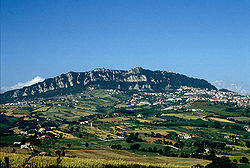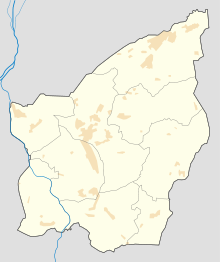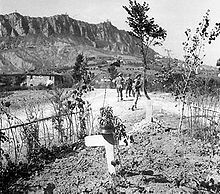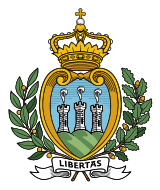- Monte Titano
-
San Marino Historic Centre and Mount Titano * UNESCO World Heritage Site
Monte Titano and three fortresses on top of it can be seen from many kilometers awayCountry San Marino Type Cultural Criteria iii Reference [[1] 1245] Region ** Europe and North America Inscription history Inscription 2008 (32nd Session) * Name as inscribed on World Heritage List
** Region as classified by UNESCOMount Titano 
Rocca o Chesta, the highest of Monte Titano's summitsElevation 739 m (2,425 ft) [2] Prominence 189 m (620 ft) [2] Listing Country high point Location Location in San Marino Location San Marino Range Apennines Coordinates 43°55′42″N 12°27′08″E / 43.92833°N 12.45222°ECoordinates: 43°55′42″N 12°27′08″E / 43.92833°N 12.45222°E Monte Titano ("Mount Titan")[3] is a mountain of the Apennines and the highest peak in San Marino. It stands at 739 m (2,425 ft) above sea level[4] and is located immediately to the east of the capital, San Marino. It was inscribed as a UNESCO World Heritage Site in 2008 under the combined title "San Marino Historic Centre and Mount Titano". Inscribed under reference no. 1245 criteria iii, the two together encompass an area of 55 ha with a buffer zone of 167 ha. It encompasses the Mount Titano and the other structures such as the fortification towers, walls, gates and bastions, as well as a neo-classical basilica located on it and its slopes forming a small but unique urban conglomerate.[1][5]
Straddled on the ridge of Mount Titano is the city of San Marino of the Republic of San Marino on the eastern part of the Italian peninsula, it has a hoary history starting from early 4th century. According to the legend related to the Mount and its precincts a small monastery existed on top of the Mount during the 8th century. The mountainous landscape provides excellent views of its surroundings, and its isolated location ensured the needed seclusion for San Marino to survive as a Republic over the past several centuries.[5][6]
Contents
History
Monte Titano during the Battle of San Marino in World War II
According to legend, Saint Marinus, a stonemason, originally from Rab (Dalmatia, Croatia) avoided Diocletian's anti-Christian persecution by escaping to Italy. Arriving in Rome, he was employed by a woman named Felicita to inscribe her dead husband's sarcophagus. While he worked, Marinus preached his Christian faith. Eventually, Felicita converted to Christianity, and subsequently gave Mount Titano to Marinus.[7] With his followers, Marinus took refuge on Mount Titano and founded a religious community there, which became a village in early fourth century (301 AD). He was ordained a deacon by Gaudenzio di Rimini, and spent some time preaching in Rimini but growing tired of that life, he returned to his hermitage on Mount Titano, built a chapel, and lived a life of contemplation.[7]
The mountain has three peaks; on each is one of The Three Towers of San Marino. In art, this sacred saint of whom the republic of San Marino takes its name from is always represented with Mount Titano in his hands.[6][8][9]
Geography and environment
Monte Titano is located in central San Marino (seen in maps in rough rectangular shape), to the southeast of the City of San Marino and to the north of the village of Murata, at a distance of 10 km (6.2 mi) from the Adriatic Coast.[6][10][11][12] Monte Titano looks like a rugged limestone outcrop, located only 13 kilometres (a figure of 10 km is mentioned in another reference) from the Adriatic Sea on the Apennines. Although the highest point is 739 metres above sea level, the rocky outcrop is about 200 metres in height at most. From the top of Monte Titano views of the entire nation of San Marino and further afield can be viewed scenically. The mountain gives birth to several streams, including the San Marino River, which flows down its western slope through a broad valley[13] and flows into the Marecchia River, through Marecchia Torello and into the Adriatic Sea 23 km (14 mi) away and the Cando River, born in Marano, which flows into the Adriatic coast between Rimini and Riccione Ausa. The terrain has fertile soils in Emilia Romagna plain and soft rolling hills in the Marche and Montefeltro region. The mountain dips into the calm Adriatic sea.[6][10]
During the Tertiary era, the area where San Marino lies was the sea. Violent earthquakes caused major upheavals in the Earth's surface. Because of these intensive earthquakes, a mass of rock situated about 80 km (50 mi) from the mountain, was lifted and slid slowly toward the Adriatic Sea. This mass of rock gave rise to various mountains, including Mount Titano. The vertebrate fossils found on the slopes of Mount Titano are mostly aquatic in origin, because of the fact this rock was once located underneath the sea in its current spot. Fossils of various fish, especially the fossils of shark teeth have been discovered on Monte Titano, with many dated to the Miocene period.[14] The most important fossil discovery is that of a whale, which is now preserved in the Bologna Archaeological Museum.
The precincts of Monte Titano and the San Marino city experiences mild temperate climate; the maximum temperatures reported is of 79 °F (26 °C) in summer while the minimum is 19 °F (−7 °C) in winter. Annual precipitation varies from about 22 inches (560 mm) to 32 inches (800 mm).
Flora and fauna
Set in the Mediterranean zone the vegetation is typical influenced by elevation variations. Numerous trees inhabit the mountain, including chestnuts, oaks, laburnum, cypress, fir trees and some shrubs and asparagus, typical of the driest areas, such as the territory in the Three Towers of San Marino vicinity. On the cliffs of Mount Titano is also found Ephedra Nebrodensis, a plant typical of Sicily and Sardinia.
Wildlife is represented by all classes of vertebrates and, given the characteristics of the mountainous territory, birds and mammals are the most common animals. In relation to birds, several can be mentioned such as the kestrel, barn owl, owl, tawny owl, the magpie and buzzards. Common animal life includes roe deer, wild boar, deer, weasels, marten, porcupine, hare, hedgehogs, polecats, badgers and foxes.[6]
Protected area
Since 2008, Monte Titano was allocated as a UNESCO World Heritage Site, in tandem with the historic centre of San Marino. The reason given by the Committee refers to "witnessing the continuity of a free republic since Middle Ages. "[15] This heritage site include the towers, walls, gates and bastions of the City of San Marino, the Basilica di San Marino of the nineteenth century, some convents of the fourteenth and sixteenth centuries, the eighteenth century Teatro Titano Theatre and the Palazzo Pubblico of the nineteenth century.[15]
Culture
Further information: San MarinoThe layout of the Mount Titano presents three peaks, each crowned by ancient towers named Guaita, Cesta and Montale, with triple fortifications that enclose the capital city. Each tower in turn has a metal vane fixed on it which is in the shape of an ostrich plume, ("perhaps a pun on the Italian penne, meaning "plumes") which is attributed to the name of the mountains. Those three towers are represented in the coat of arms of in the central part of the National Flag (horizontal white and blue) of the country (which has a width to length ratio of 3 to 4). The capital city is set on the western side of Mount Titano.[6][16] An urban network of roads links the fortresses.[9]
References
- ^ a b "San Marino Historic Centre and Mount Titano". UNESCO.org. http://whc.unesco.org/en/list/1245. Retrieved 2010-11-03.
- ^ a b "Mount Titano" on Peakbagger.com Retrieved 30 September 2011
- ^ (in Italian) The Numismatic circular. 6–7. 1898. p. 531. http://books.google.com/books?id=WAkrAAAAMAAJ&pg=PT531.
- ^ Official Italian 1:25,000 mapping; other sources give slightly higher figures.
- ^ a b "San Marino" (pdf). UNESCO.org. http://whc.unesco.org/archive/advisory_body_evaluation/1245.pdf. Retrieved 2010-11-03.
- ^ a b c d e f "Travel & Geography: Mount Titano". Encyclopedia Brittanica. http://www.britannica.com/EBchecked/topic/521449/San-Marino/236529/Geography?anchor=ref101628. Retrieved 2010-11-03.
- ^ a b Abbott, Ernest Hamlin; Abbott, Lyman; Bellamy, Francis Rufus (1915). The Outlook. 111. Credo Harris. Outlook Co.. p. 503. http://books.google.com/books?id=pLwRAAAAYAAJ&pg=PA503.
- ^ Haggett, Peter (2002). Encyclopedia of world geography, Volume 11. Marshall Cavendish. p. 1461. ISBN 0761473009. http://books.google.co.in/books?id=qQgXLCQVFXsC&pg=PA1461.
- ^ a b "Geography of San Marino". How Discoveryworks: A Discovery Company. http://geography.howstuffworks.com/europe/geography-of-san-marino.htm. Retrieved 2010-11-03.[unreliable source?]
- ^ a b "Beyond geography". Republic Di Martino: Visitsanmarino.com. http://webcache.googleusercontent.com/search?q=cache:YLyXtcd7jYsJ:www.visitsanmarino.com/default.asp%3Fid%3D84+Geography+and+history+of+Mount+Titano&cd=6&hl=en&ct=clnk&gl=in. Retrieved 2010-11-03.
- ^ Google. Google Maps (Map).
- ^ Microsoft and Harris Corporation Earthstar Geographics LLC. Bing Maps (Map).
- ^ Scottish geographical magazine, Volumes 39–40, Royal Scottish Geographical Society, (1923)
- ^ Lawley, R. (1880). Selache manzoni n. sp. – Dente fossile délia molassa miocenica del Monte Titano (Repubblica di San Marino).. Atti della Società Toscana di Scienze Naturali, 5:. pp. 167–172, fig. 1–3.
- ^ a b "San Marino". UNESCO. http://whc.unesco.org/en/list/1245/. Retrieved November 2, 2010.
- ^ "Flag of San Marino". Encyclopedia Brittanica. http://www.britannica.com/EBchecked/topic/1355487/San-Marino-flag-of?anchor=ref716883. Retrieved 2010-11-03.
Categories:- Mountains of San Marino
- World Heritage Sites in San Marino
- San Marino (city)
Wikimedia Foundation. 2010.






